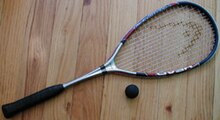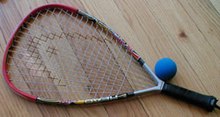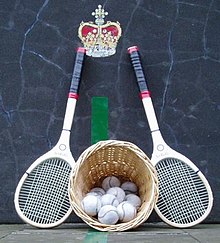Racket (sports equipment)


A racquet (or racket) is a sports implement consisting of a handled frame with an open hoop across which a network of cord is stretched. It is used for striking a ball in such games as squash, tennis, racquetball, and badminton. Collectively, these games are known as racquet sports.
The frame of raquets for all sports was traditionally made of laminated wood and the strings of animal intestine known as gut. The traditional raquet size was limited by the strength and weight of the wooden frame which had to be strong enough to hold the strings and stiff enough to hit the ball or shuttle. Manufacturers started adding non-wood laminates to wood racquets to improve stiffness. Non-wood racquets were made first of steel, then of aluminium, and then carbon fiber composites. Wood is still used for real tennis, racquets, and xare. Most racquets are now made of composite materials including carbon fibre, glassfibre, metals such as titanium alloys or ceramics.
Gut has partially been replaced by synthetic materials including nylon, polyamide, and other polymers. Racquets are restrung when necessary, which may be after every match for a professional or never for a social player.
Badminton

Badminton racquets are light, with top quality racquets weighing between about 70 and 100 grams (with strings). Modern racquets are composed of carbon fibre composite (graphite reinforced plastic), which may be augmented by a variety of materials. Carbon fibre has an excellent strength to weight ratio, is stiff, and gives excellent kinetic energy transfer. Before the adoption of carbon fibre composite, racquets were made of light metals such as aluminium. Earlier still, racquets were made of wood. Cheap racquets are still often made of metal, but wooden racquets are no longer manufactured for the ordinary market, due to their excessive weight and cost.
There is a wide variety of racquet designs, although the racquet size and shape are limited by the Laws. Different racquets have playing characteristics that appeal to different players. The traditional oval head shape is still available, but an isometric head shape is increasingly common in new racquets.
Rackets
This predecessor to the modern game of squash, rackets, is played with 30½ inch (775 mm) wooden racquets. While squash equipment has evolved in the intervening century, rackets has changed little.
Racquetball
According to the current USA Racquetball rules there are no limitations on shape or weight of a racquetball racquet.
Rule 2.4 RACQUET SPECIFICATIONS
(a) The racquet, including bumper guard and all solid parts of the handle, may not exceed 22 inches in length.
(b) The racquet frame may be any material judged safe.
(c) The racquet frame must include a cord that must be securely attached to the player's wrist.
(d) The string of the racquet must be gut, monofilament, nylon, graphite, plastic, metal, or a combination thereof, and must not mark or deface the ball.
(e) Using an illegal racquet will result in forfeiture of the game in progress or, if discovered between games, forfeiture of the preceding game.
Racquetball racquets, unlike many other types, generally have little or no neck; the grip connecting directly to the head. They also tend to have head shapes that are notably wider at the tip, some even verging on triangular.
Real Tennis

The 27 inch (690 mm) long racquets are made of wood and use very tight strings to cope with the heavy ball of Real Tennis. The racquet head is bent slightly to make it easier to strike balls close to the floor or in corners.
Squash
'Standard' squash racquets are governed by the rules of the game. Traditionally they were made of laminated timber (typically Ash), with a small strung area using natural 'gut' strings. After a rule change in the mid-1980s, they are now almost always made of composite materials or metals (graphite, Kevlar, titanium, and/or boron) with synthetic strings. Modern racquets are 70 cm long, with a maximum strung area of 500 square centimetres (approximately 75 square inches) and a weight between 110 and 200 grams (4-7 ounces).
Tennis

Modern tennis racquets vary in length, weight, and head size. 21" to 26" is normally a junior's length, while 27" or 27.5" are for stronger and taller adult players. Weights of a racquet also vary between 9 ounces unstrung and 12.5 ounces unstrung. Head size also plays a role in a racquet's qualities. A larger head size generally means more power, and a larger "sweet spot" that is more forgiving on off-center hits. A smaller head size offers more precise control. Head sizes of recent racquets vary between 85 sq. inches and 137 sq. inches.
Throughout most of tennis' history, racquets heads were around 65 square inches and racquets were made of laminated wood. In the late 1960s, Wilson produced theT2000 steel racquet with wire wound around the frame to make string loops. It was popularized by American top player Jimmy Connors. In 1975, aluminum construction allowed for the introduction of the first "oversized" racquet which was manufactured by Weed. Prince popularized the oversize racquet had a head size of approximately 110 square-inches and opened the door for the introduction of racquets having other non-standard head sizes such as midsize 90 square-inches and mid-plus size 95 square-inches. In the early 1980s, "graphite" (carbon fibre) composites were introduced, and other materials were added to the composite, including ceramics, glassfibre, boron, and titanium. The Dunlop Max200G used by John McEnroe from 1983 was an early graphite racquet, along with the very popular Prince "Original" Graphite. Composite racquets are the contemporary standard.
Longer racquets were introduced by Dunlop[1] in order to give additional reach for shots such as the serve and volley where shorter players may be at a disadvantage. Midsize or mid-plus racquets are the general standard for professional players.
Stringing (material, pattern, tension) is an important factor in the performance of a tennis racquet. A few elite players use natural gut, but the vast majority of strings are a nylon or polyester synthetic. Some (American champion Pete Sampras a prominent example) consider the natural string to be more responsive, providing a better "feel", but synthetic is favored for its much superior durability, consistency, as well as much lower cost. String pattern (the vertical/horizontal grid) is a function of the racquet head size and design. A tighter pattern is considered to deliver more precise control; a more "open" pattern to offer greater potential for power and spin. Modern racquets are marked with a recommended string tension range. The basic rule is that a lower tension creates more power (from a "trampoline" effect) and a higher string tension creates more control (the ball stays on the strings longer, for more "feel" and shot direction.)
Double strung tennis racquets were introduced in 1977[2] and then banned because they permitted excessive spin. [3]. A modern version of a legal double strung racquet has been introduced [4].
See also Strings (tennis).
Choosing a Tennis Racquet
Choosing the right racquet will often boost a player's game. Racquet manufacturers such as Head, Wilson, Prince, Yonex, and Babolat, just to name a few, constantly introduce new lines of racquets each year. Depending on your budget, there are plenty of racquets to choose from, however; choosing the right one for your game is the key. There are several guidelines such as grip size, head size, length, flex, string patterns, weight, and balance to take into considerations before making the investment. The best thing to do is to demo different type of racquets to feel the difference before you decide on which one to buy. Most tennis shops provides demo program for their customers.
Grip Size
Choosing the right size of grip is essential. The grip size is measured as the length of the perimeter of the octagonal cross-section of the handle. Grip sizes 3⅞ and 4 are for juniors where 4¼, 4⅜, 4½, and 4⅝ are for adults. The average size for female is 4¼, while the average size for male is 4⅜. To determine the right grip size, hold the racquet where your palm is on the same bevel as the string face. You should be able to comfortably fit your index finger in the space created between your ring finger and your palm that is holding the racquet. If there is not enough space for your index finger, then the grip is too small. If there is too much space then the grip is too big. If you are in between two grip sizes, pick the smaller one. You can always make the grip bigger by adding an overgrip which will increase the size by 1/16 or half a grip size.
Head Size
Head size is the measure of the hitting area. A midsize racquet has a hitting area of 85-95 square inches, mid-plus 95-105 square inches, and oversize greater than 105 square inches. Bigger head size racquet offer more power and spin, however; they lack maneuverability and stability. Smaller head size racquet offer more control and less power. In general, more accomplished players tend to use mid-size and mid-plus racquet because they can generate more power on their own and need a racquet that they can control their power with. Larger racquets usually appeal more to beginner and intermediate players who are looking for more power and larger sweet spot.
Racquet Length
The standard length of a tennis racquet is 27 inches. However, in recent years, manufacturers introduced extra long or stretch racquets which ranges from 27.5 to 29 inches long. These racquets, called extended length racquets, can give players more power and slightly extra reach. Usually, the extra long racquet is lighter in weight compared to its standard length counterpart to keep it maneuverable.
Flex
The flex or stiffness of a tennis racquet is the racquet’s resistance to bending or deforming upon impact with the ball. A stiffer racquet bends less, thus depleting less energy from the ball and offers more power. A flexible racquet bends more, resulting in more energy loss and less power. Players with short swing would want to have stiffer racquets since it will give the most power. A much less stiffer racquet give less power and would suit players with longer swing who can generate their own power. Stiff racquets also offer solid feel while less stiff racquets have a softer feel. One thing to keep in mind is the highly stiff racquets tend to give players tennis elbow.
String Pattern
String pattern is measured by how many strings go up and down (called mains) and how many strings go side to side (crosses) when your racquet is fully strung. An “open” string pattern is one where there is a lot of empty space in the string bed because there are less strings. A 16 x 18 is a common "open" string pattern where 18 x 20 is an example of a “closed” string pattern.
Open string patterns are popularly thought to allow for more spin potential, as the ball can embed itself into the strings more, due to their wider spacing. However, recent scientific studies have found that stringbed properties do not directly affect spin potential of a racket. A more open string pattern does make for higher deflection angles, which results in higher arch in ball's trajectory - this difference in deflection angle may give an impression of more spin.[1]
One drawback of open string pattern is it reduces the string’s durability. Open string patterns place more impact stress on individual strings and also allow the strings to move more freely, increasing abrasion which causes string breakage.
Weight
Technology has played a big role in racquet weights. Until the 1990s, tennis racquet weighed an average of 12-13 ounces. When Hammer technology was introduced by Wilson, it reduced the weight to 10-11 ounces. Nowadays, most manufacturers offer sub 10 ounces racquets. Heavier racquets are less maneuverable but more powerful and more stable than the lighter counter part. Lighter racquets generally are best suited for beginner and intermediate players because of its maneuverability. More accomplished players tend to use the heavier racquets. When examining the weight of the racquet, it is also important to understand the weight balance of it.
Balance
Racquets with the same weight could have different balance. A racquet with more weight distributed on the head rather than the handle is called a head heavy racquet, and the opposite is called a head light racquet. Head heavy racquets will give players more power but lacks in maneuverability because of its weight distribution. On the other hand, head light racquets provide more control and maneuverability. Most accomplished players tend to choose head light racquets.
Table tennis

Tennis racquet with 3 different sizes of the celluloid ball.
Xare
In the form of Basque pelota known as xare, the racquet (called an Argentine racquet) is made of a hoop in hazel or chestnut wood, and is somewhat loosely strung. The ball is not exactly struck, nor is it quite caught—the effect is somewhere in between : you have to catch the ball in the net then you send it back with a quick fist stroke.!
External links
- [1] The Physics and Technology of Tennis - by Howard Brody,Rod Cross,Crawford Lindsey[5]
- Find Your Perfect racquet
- Selecting the Right Racquet
- The Tennis Coach
- Selecting the Right Grip Size
- Tennis racquet design by Howard Head; (1974) Smithsonian Institution Libraries
- Website for old tennis racquets & collectibles
- The History of Tennis Racquets - Evolution of the Modern Racquet
- How Products are Made - Tennis Racquet
- The Big Technological Tennis Upset Template:Link FA
- ^ [1]
